14 December. Locusts concentrating and increasing in density in Niger
Small groups of late instar hoppers and immature adults are present in parts of the Tamesna Plains in northern Niger northwest of Agadez. The groups have formed as Desert Locust hoppers and adults concentrate and increase in density in the few areas that remain green in between the sand dunes. Despite security concerns, ground teams are monitoring the situation and 121 ha were treated on 10-13 December. It is important that field teams try to locate and control all infestations in order to reduce grouping and diminish the threat to crops and migration to other countries.
In western Mauritania, the situation continues to improve in areas where an outbreak developed in early October. Very little rain has fallen and vegetation continues to dry out. Consequently, only low numbers of scattered hoppers and adults are present mixed with a few small groups. National teams treated 75 ha during the first ten days of December.
In southern Morocco, a few isolated adults were seen in the southern part of the Western Sahara near Tichla and the border of Mauritania.
Elsewhere, the situation remains calm with only a few locusts reported in the winter breeding areas along the Red Sea coast in the Tokar Delta, Sudan and on the northwest coast in northern Somalia.
The situation should continue to be monitored carefully in the above-mentioned countries and preventive control operations undertaken as necessary.
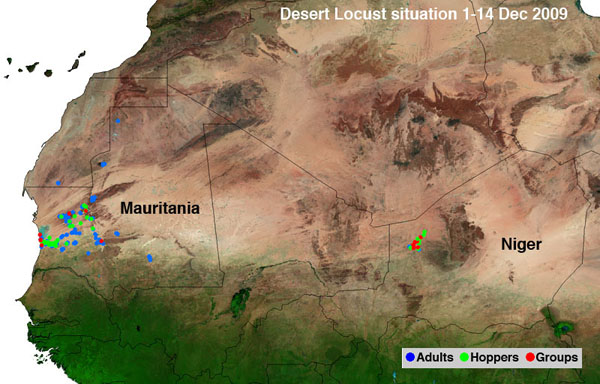
Groups of locusts are present in Mauritania and Niger.
2 December. Desert Locust situation continues to improve in Mauritania
The Desert Locust situation continues to improve in western Mauritania as a result of ground control operations and very little rainfall. In the past few days, control operations have declined as locust infestations become smaller and potential targets are more scarce. The situation is expected to improve further unless unusually heavy and widespread rains fall but this is unlikely.
In the winter breeding areas along both sides of the Red Sea, limited breeding is expected to occur once rains fall but locust numbers will remain below threatening levels. So far, rains have only occurred in northeast Sudan and near Jeddah, and low numbers of solitarious adults are present in Sudan near the border of Egypt and in the Tokar Delta.
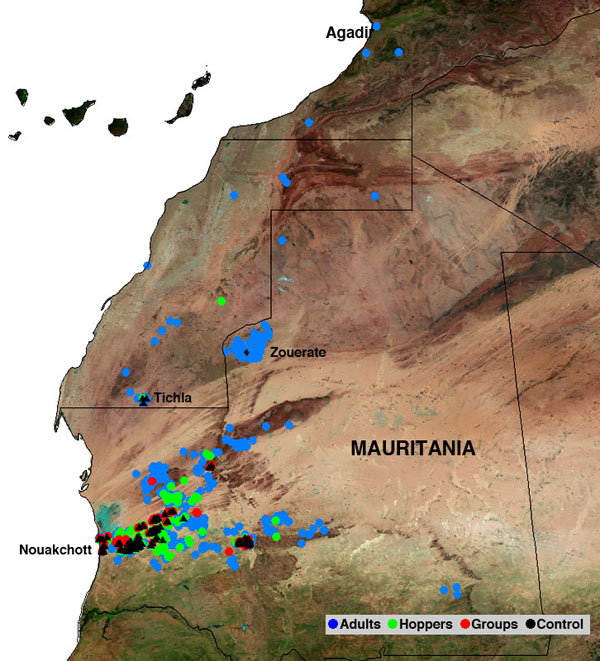
The locust situation is improving in W Mauritania.
24 November. Desert Locust situation improving in Mauritania
The Desert Locust situation is improving in western Mauritania where ground control operations continue against small groups of hoppers and adults as a result of an outbreak that developed in early October. During the past five days, locust densities and control operations have declined compared to earlier this month. Most of the hoppers have reached their last stage of maturity and are now fledging into immature adults. Consequently, ground teams are finding less targets to treat but remain in the field to monitor the situation carefully.
In the extreme south of Morocco, ground teams treated very small patches of first and second instar hoppers near Tichla in the Western Sahara. These infestations developed from adults that arrived from outbreak areas in Mauritania during early October. They laid eggs in mid-October when light rains fell, which hatched during the second week of November. Similar breeding may have occurred in nearby areas but probably on a very limited scale.
Given the effectiveness of current control operations, a high level of preparedness in the region, and a lack of significant rainfall, it is expected that the outbreak should be under control by early December. Thereafter, only low numbers of locusts are likely to remain in parts of western and northern Mauritania and Western Sahara where small-scale breeding could occur if ecological conditions are favourable. There is no threat at present to other countries in the region.
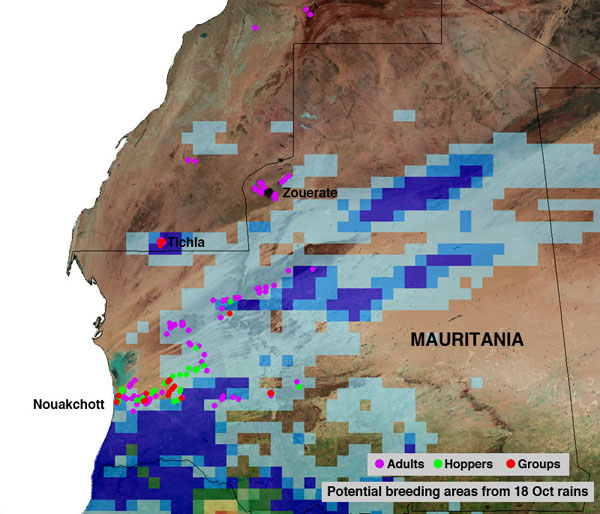
Control operations are in progress in Mauritania and Western Sahara.
13 November. Control operations increase in Mauritania outbreak
During the past two weeks, control efforts by national teams have increased in western Mauritania where a Desert Locust outbreak developed in early October. Nearly 6,400 ha were treated by ground so far this month, bringing the total area treated since 11 September to 10,600 ha.
Currently, second generation hoppers continue to form small groups within a remote area between Nouakchott, Moudjeria and Oujeft. Some of the immature and mature adults are also forming groups, mainly near Moudjeria and Nouakchott while egg laying continues in a few areas between Aguilal Faye and Akjoujt.
Light to moderate rains fell on 1-2 November near Zouerate which should allow conditions to remain favourable for locust survival and small-scale breeding. Although rain has not fallen in the outbreak area since late September, vegetation remains green in between the sand dunes.
Given the effectiveness of current control operations, a high level of preparedness in Mauritania and the region, and a lack of significant rainfall, it is expected that the outbreak should be under control by early December. Thereafter, only low numbers of locusts are likely to remain in the area and perhaps breed on a limited scale if temperatures remain warm. Scattered adults are likely to move into parts of southern Morocco and Western Sahara. There is no threat at present to other countries in the region.
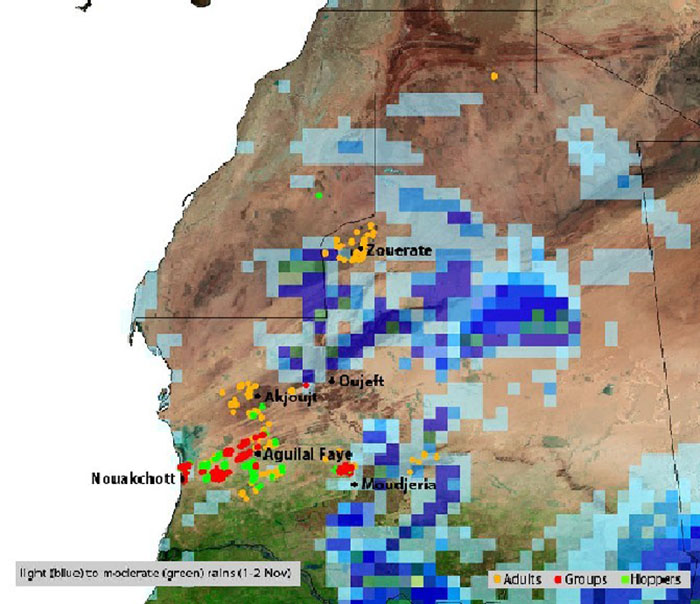
Control operations increased in western Mauritania against a Desert Locust outbreak.
2 November. Control operations in progress in Mauritania outbreak
Ground teams continue to treat second generation hatchlings and hoppers that are forming small groups in western Mauritania. The outbreak developed as a result of summer breeding, giving rise to increased numbers of locusts that are concentrating in vegetation that remains green within an area of about 400 km by 250 km east of Nouakchott. So far, teams have treated some 4,000 ha since mid September.
The outbreak is smaller than in 2003 and Mauritania is better prepared with sufficient resources to combat new hopper groups as they form during November. Very little rain fell in the Region during October, which means that breeding is likely to end shortly unless more rains fall. This, combined with effective control operations against primarily hopper infestations, should reduce locust numbers and bring the situation under control and stop the migration of adults towards the north. So far, only isolated solitarious immature adults have arrived in adjacent areas of southern Morocco and Western Sahara.
Elsewhere, low numbers of adults were present in central Mali, southern Algeria, northern Niger, Chad and on the Red Sea coast in Yemen.
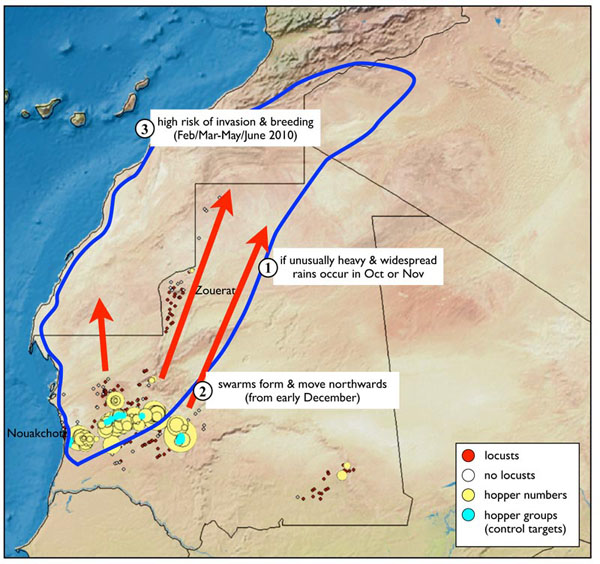
The Desert Locust outbreak in western Mauritania should be contained unless unusually heavy and widespread rains occur in the next six weeks.
23 October. Desert Locust control operations continue in western Mauritania
Seventeen survey and control teams from the National Locust Centre in Mauritania are undertaking ground operations against a second generation of Desert Locust breeding that is underway in western Mauritania where a potentially serious outbreak developed earlier this month. The new hatchlings are gregarizing and forming small but dense hopper groups that are good targets for control. More than 2,100 ha have been treated since the control operations started on 11 September.
The outbreak is smaller than the outbreak in 2003 that led to a regional plague in 2004-05. No significant rain has fallen this month and vegetation is starting to dry out. All countries within the region are much better prepared than in 2003 and have sufficient resources in place to bring the current outbreak under control. Although there is no immediate threat to other countries in the Region, they are on standby and ready to help Mauritania if needed. Morocco has mobilized survey teams and two aircraft in the extreme south of the Western Sahara just in case locust adults arrive from Mauritania. So far, ecological conditions remain dry in southern Morocco and no significant locust infestations have been detected.
Therefore, the current outbreak is expected to be brought under control by early December unless unusually heavy and widespread rains occur in the next six weeks. If that was to occur and if current control operations are less effective than expected, then there is a risk that small swarms will form in early December in the outbreak area and move north into northern Mauritania and southern Morocco and breed during the winter. This could eventually lead to further migration and breeding during the spring as far north as the Atlas Mountains in Morocco and Algeria.
FAO is monitoring the situation extremely closely on a daily basis and will continue to keep affected countries, the donor community and other stakeholders informed of any significant developments as they arise.

The Desert Locust outbreak in western Mauritania should be contained unless unusually heavy and widespread rains occur in the next six weeks.
15 October. Desert Locust outbreak develops in western Mauritania
A serious Desert Locust outbreak has developed in western Mauritania from breeding that occurred this summer. At present, there is no threat to other countries in the Region except for southern Morocco and Western Sahara where adults from currently infested areas in western Mauritania could appear. If the outbreak is not controlled and if unusually heavy and widespread rains were to fall in the next two months, then the situation will deteriorate further and there is an extremely high risk that it could lead to the early stages of an upsurge in the Region.
All efforts should be made to ensure that adequate survey and control operations are carried out during October and November in the outbreak area. Fortunately, sufficient resources are in place to face the current threat.
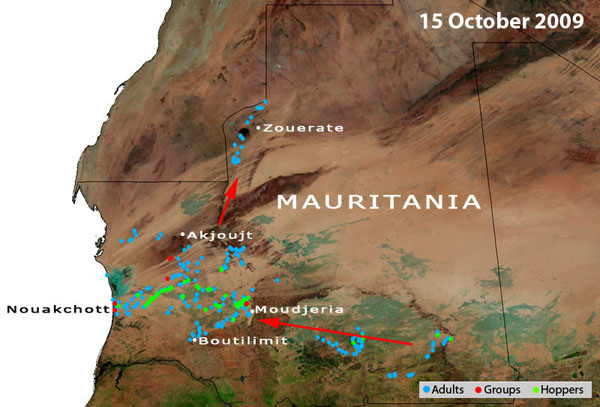
A Desert Locust outbreak has developed in western Mauritania.
1 October. Locust populations may increase in Mauritania
Desert Locust adults are dispersed widely throughout the northern Sahel in Mauritania and breeding is in progress. As vegetation dries out in October, adults are expected to move from the south and southeast and appear in areas of recent rainfall in the northwest of the country. Breeding is likely to commence in the northwest and continue east of Nouakchott, giving rise to more locusts that could concentrate and form small groups.
Elsewhere in the summer breeding areas, lower numbers of locusts are present in eastern Chad and probably in parts of northern Mali and Niger, Sudan and western Eritrea but surveys have not been carried out recently in these countries to confirm the situation. Unless further rains fall, vegetation will dry out and only low numbers of locust adults are expected to remain.
In Southwest Asia, the seasonal monsoon was unusually poor in the summer breeding areas along both sides of the Indo-Pakistan border and, as a result, there was no significant locust activity this year.
The forecast period until mid-November is one in which summer generation adults normally move to the autumn breeding areas in northwest Mauritania and winter breeding areas along both sides of the Red Sea. This year, small-scale movement and breeding is expected to occur in both areas.
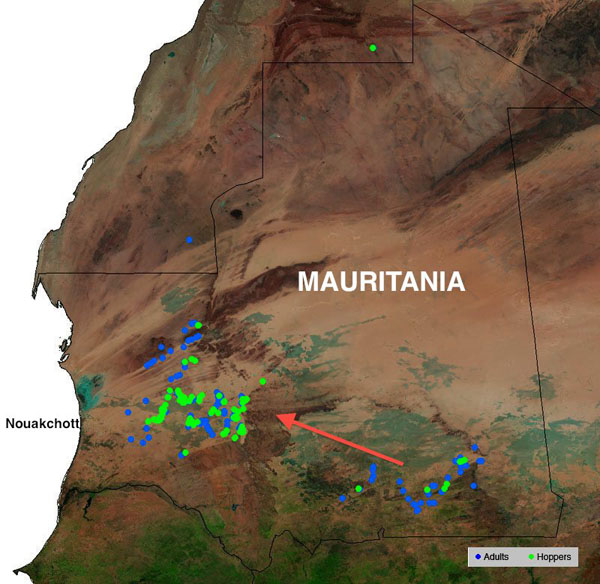
The Desert Locust situation remains calm.
1 September. Locust populations are expected to increase substantially in Mauritania
Desert Locust adults are dispersed widely throughout the northern Sahel in Mauritania and breeding is in progress. Locusts are also present or are likely to be present, but to a lesser extent, in some of the summer breeding areas in northern Mali and Niger, southern Algeria, eastern Chad, Sudan and western Eritrea. National locust teams are conducting ground surveys and monitoring the situation in all countries except for Mali and Niger because of continued insecurity. So far this season, the level of breeding is about normal. Good rains have fallen in Mauritania, Sudan and Eritrea but they have been patchy in the other countries.
Small-scale breeding will continue during September and into October, which will cause locust numbers to increase substantially in Mauritania, and this could eventually lead to a local outbreak once vegetation starts to dry out in October. Locusts will also increase in northern Mali, Niger, Chad, Sudan and Eritrea but they should remain below threatening levels.
In late July, unusually heavy rains fell along both sides of the southern Red Sea over the entire coast of Eritrea, Djibouti and Yemen. This will cause ecological conditions to improve and small-scale breeding could eventually occur in some areas.
In Southwest Asia, monsoon rains were very poor during August in the summer breeding areas along both sides of the Indo-Pakistan border. Consequently, only low numbers of locusts are present and breeding is not likely to occur unless more rains fall.
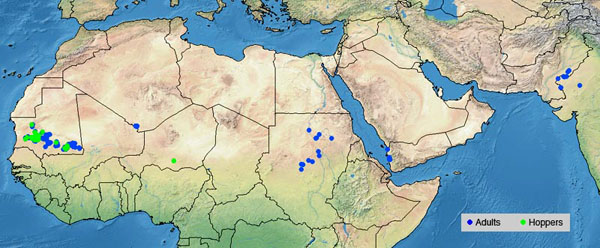
The Desert Locust situation remains calm.
3 August. Desert Locust situation returns to calm in all countries
In the past few weeks, the Desert Locust situation has improved in the Horn of Africa, and the situation is now calm in all countries.
Only insignificant numbers of solitarious adults are present in northwest Mauritania, Algeria and Sudan. Local breeding was reported in one place in northwest Mauritania where unusually good rains fell in June. In July, ground control teams treated small infestations along the Algerian border in Morocco and in the northern highlands in Ethiopia.
Seasonal rains began last month in the summer breeding areas in the northern Sahel from Mauritania to Eritrea. By the end of July, ecological conditions had become favourable in most areas. Consequently, small-scale breeding will occur during August, causing locust numbers to increase slightly but remain below threatening levels.
In Southwest Asia, the monsoon rains commenced in early July and, like the Sahel, conditions are now favourable for breeding. So far, only scattered locusts are present in Cholistan and Khipro deserts in Pakistan near the Indian border. Small-scale breeding in both countries will cause locust numbers to increase slightly but remain below threatening levels during August.
Regular surveys should be carried out in all affected countries to monitor the situation carefully throughout the summer.
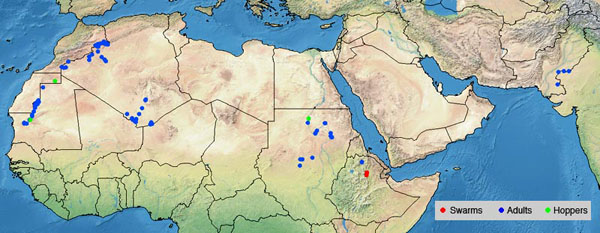
The Desert Locust situation has improved in the past month.
2 July. Desert Locust situation calms down in the Horn of Africa and Arabia
In the past week, the Desert Locust situation has improved in the Horn of Africa and in southern Arabia. In Ethiopia, no new swarms have been reported and only a few small immature swarms and swarmlets remain in parts of the central Rift Valley and in the northern highlands. Those in the northern highlands have dispersed and are difficult to treat. Consequently, there is a moderate risk that scattered adults and perhaps a few small groups of adults could move to the summer breeding areas in western Eritrea and central Sudan and lay eggs with the onset of the seasonal rains.
Only a few scattered immature adults were seen during surveys last week in the interior of Yemen, mainly north of Wadi Hadhramaut in Zamakh and Minwakh areas, and on the escarpment in northern Somalia. No locusts were seen during surveys carried out recently in Oman, Pakistan and India.
Therefore, it appears that the threat of swarm movement from Yemen and northern Somalia to the summer breeding areas along both sides of the Indo-Pakistan border has ceased. Nevertheless, regular surveys should be maintained in the key countries throughout the summer.
Elsewhere, the situation remains calm. A few locusts are present and breeding south of the Atlas Mountains in Morocco and along the Nile River Valley in northern Sudan. Control operations were carried out in southeast Iran against hoppers.
In the coming weeks, small-scale breeding will commence with the onset of the seasonal rains in the northern Sahel of West Africa and Sudan as well as along the Indo-Pakistan border. Locust numbers are likely to remain low and no significant developments are expected.
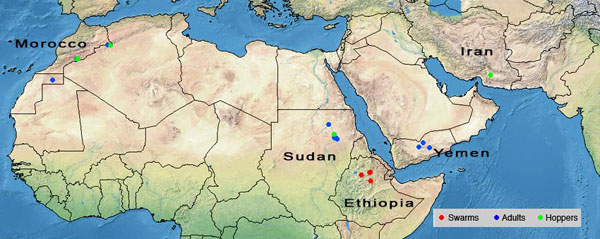
The Desert Locust situation has improved in the past week.
19 June. Desert Locust swarms persist in Ethiopia and N Somalia
In Ethiopia, no new swarms have arrived from northern Somalia since 10 June but there are about a dozen swarms reported in the country. Many of the swarms split into smaller swarmlets and groups that have moved into the Somali region (Shinile and Jijiga zones), Dire Dawa, Oromiya (E. and W. Haraghe zones), Harari, and the central Rift Valley in Afar (zones 3 and 5). A small swarm moved into the northern highlands (North Wello) on 9 June and reached southern Tigray on the 12th. Small groups of adults also arrived in southern Gondar zone in Amhara region on the 14th. Control operations are nearly impossible because the immature swarms are very mobile and difficult to follow in the rugged and inaccessible terrain. Some damage occurred on irrigated cotton crops in the Afar region.
The situation in northern Somalia and in Yemen remains unclear due to a lack of surveys. Ground surveys resumed today in northern Somalia to check areas on the plateau and escarpment where immature swarms have been reported between Boroma and Erigavo.
There remains a high risk that a few small swarms from northern Ethiopia could reach the summer breeding areas of western Eritrea and central Sudan while other swarms from northern Somalia could cross the Gulf of Aden and move along the eastern coast of the Arabian Peninsula and cross the Arabian Sea to the summer breeding areas along the Indo-Pakistan border. National locust teams are on alert and have been mobilized in Eritrea, Sudan, Oman, Pakistan and India. So far, no swarms have been reported in these countries.
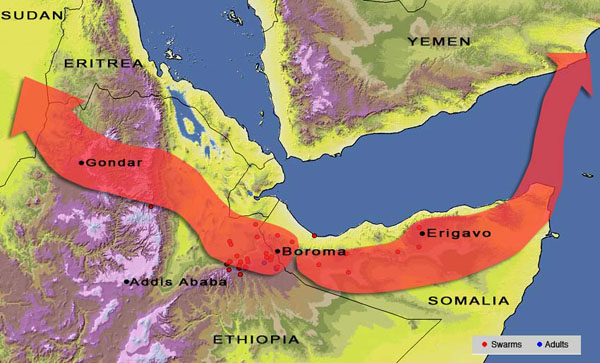
So far Desert Locust swarms have remained in Ethiopia and N. Somalia.
12 June. Desert Locust swarms may move to southern Arabia and the Indo-Pakistan border
New reports indicate that Desert Locust swarms have been moving east across northern Somalia and reached the northeast on 6 June. Two days later, an immature swarm flew over Erigavo and moved north into the nearby Golis Mountains. There is a high probability that other small swarms are still present on the plateau east of Hargeisa and Burao in the Sanaag and Bari regions of the northeast. The swarms are immature and highly mobile. They are not mature enough to lay eggs now. As ecological conditions are mainly dry and unfavourable, there is a high risk that the swarms will continue to move east and northeast towards Bosaso and the Gulf of Aden.
The southwest monsoon winds are expected to carry most of the swarms across the Gulf of Aden to the southern shores of the Arabian Peninsula where they are likely to appear briefly along the coast of eastern Yemen and southern Oman in the next few days. From there, the swarms are expected to move northeast along the dry eastern coast of Oman and cross the Arabian Sea to the coast of Pakistan and to the Rann of Kutch, India before reaching the summer breeding areas along both sides of the Indo-Pakistan border in about a week from now.
Given the current situation and the uncertainty about the scale of the potential migration, countries should be proactive and take preventive steps by mounting surveys in the following areas to monitor the arrival and movement of any swarms from northern Somalia:
* Yemen - coastal areas from Al Ghaydah to the Oman border (immediately for at least one week)
* Oman - coastal areas from Salalah to Sur (from 13 June for at least one week)
* Pakistan - coastal areas from Gwadar to the India border (from about 17 June) and eastern desert areas of Tharparkar and Cholistan
* India - coastal areas of Gujarat (from about 18 June) and interior areas of Gujarat and Rajastan
The swarms are likely to be highly mobile and difficult to control. If any swarms arrive in the summer breeding areas along both sides of the Indo-Pakistan border, they will mature quickly and lay eggs with the onset of the seasonal monsoon rains later this month.
In Ethiopia, an immature swarm appeared in the highlands north of Addis Ababa on 10 June. Survey teams have been mobilized in all areas. A few more swarms from northwest Somalia may appear in the northern Rift Valley and move through the Afar region to northwest Ethiopia (Amhara and Tigray regions) and perhaps continue towards the summer breeding areas in western Eritrea and central Sudan.
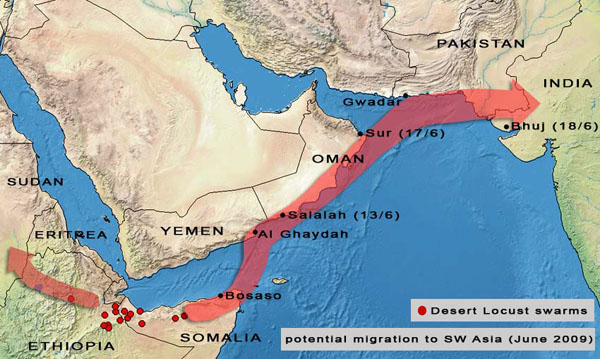
Swarms may migrate from northern Somalia towards India and Pakistan in the coming week.
10 June. Swarms from N. Somalia move into eastern Ethiopia
The current Desert Locust situation remains critical in the Horn of Africa and on the southern Arabian Peninsula.
In the past few days, at least five small immature Desert Locust swarms crossed into eastern Ethiopia from adjacent areas in northwest Somalia. Aerial control operations were immediately mounted and treated a 1.5 sq. km swarm near Harar on 7 June and a 1 sq. km swarm near Dire Dawa on the 8th. The swarms are very mobile and difficult to follow. There are also reports of swarms in the Rift Valley north of Dire Dawa and in the Harar Highlands between Dire Dawa and Harar in the Shinile and Komblocha areas.
The irregular and highly variable winds are carrying the swarms back and forth across the Ethiopian/Somali border between Djibouti and Boroma, N. Somalia. Consequently, there is a high risk that swarms may move in a number of different directions:
1) from NW Somalia (between Boroma, the coast and Djibouti) southwest to Dire Dawa and the Rift Valley in Ethiopia, reaching the highlands north of Addis Ababa and perhaps continuing to the summer breeding areas in Sudan and Eritrea
(2) from the plateau and escarpment in NW Somalia (between Boroma and Hargeisa) northeast to the Berbera coast
(3) from the plateau and escarpment (between Hargeisa and Burao) northwards to the Gulf of Aden, perhaps reaching southern Yemen
(4) from the plateau (east of Burao) northeast to Puntland and the Gulf of Aden, perhaps reaching southern Oman and continuing to the summer breeding areas along both sides of the Indo-Pakistan border.
Today, an immature swarm was seen in the highlands north of Addis Ababa in North Wello zone. National survey teams have been deployed in northern Ethiopia.
Given the complexity of the possible migrations and the seriousness of the current situation, the concerned countries (Eritrea, Ethiopia, Oman, Somalia, Sudan et Yemen) should be alert and take the necessary precautions.
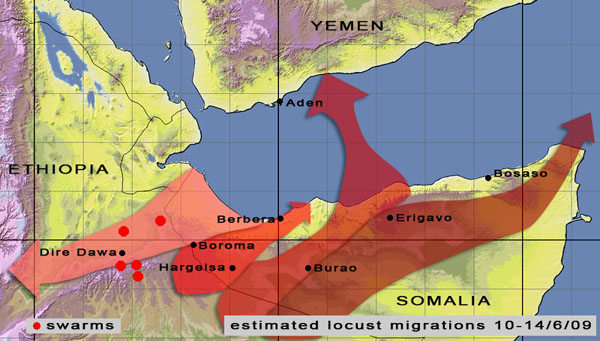
Swarms are likely to move in different directions due to variable winds over the Horn of Africa.
2 June. Swarms form in N. Somalia and threaten the Region
The current Desert Locust situation is critical in the Horn of Africa and on the southern Arabian Peninsula.
In the past week, new swarms have formed in northern Somalia. Most of the swarms are moving in a generally northerly direction on the Somali plateau and escarpment but a few swarms crossed the border into adjacent areas of eastern Ethiopia. Although ground and aerial control operations are in progress, more swarms are expected to form in northern Somalia this week as breeding comes to an end. While most of the swarms should remain on the plateau because of good rains last month, there is a high risk that some will move. As the southwest Asia monsoon flow is established over the Horn of Africa, southwesterly winds could easily carry the swarms east along northern Somalia and northeast across the Gulf of Aden to southern Yemen and Oman. From there, they could continue up the coast of Oman and cross the Arabian Sea to the summer breeding areas on both sides of the Indo-Pakistan border.
There is also a possibility that some swarms could move into the northern Rift Valley of Ethiopia and continue towards the northwest, reaching summer breeding areas in western Eritrea and eastern Sudan. Their migration routes depend on the position of the Inter-Tropical Convergence Zone (ITCZ).
New swarms are expected to form in the interior of Yemen from this week onwards. Although ground control operations are in progress against late instar hopper bands north of Wadi Hadhramaut on the edge of the Empty Quarter, it is difficult to find and treat all infestations in this large remote area. Since vegetation is drying out, any swarms that form are likely to move into cropping areas in Wadi Hadhramaut and the central highlands, while others could move towards the southern coast and then northeast towards Pakistan and India via Oman.
All countries should be alert and take the necessary precautions.
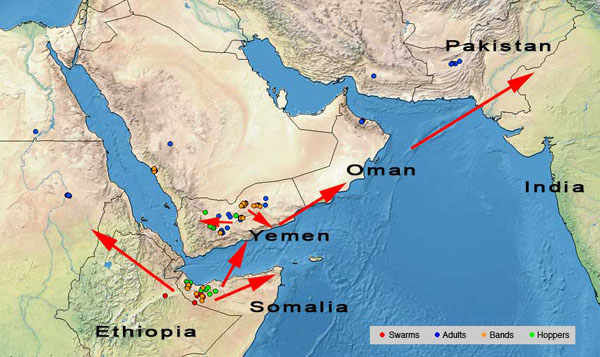
Swarms are forming in Yemen and N. Somalia and threaten other countries.
21 May. Eggs hatch and hoppers form bands in Yemen and N. Somalia
The current Desert Locust situation remains a cause for concern in Yemen, northern Somalia and Ethiopia.
In Yemen, hatching has been underway since the beginning of this month in the interior along the edge of Ramlat Sabatayn between Al Hazm, Ataq, Al Abr and Wadi Hadhramaut. Hoppers have formed small groups in all of these areas and numerous small bands with densities up to 200 hoppers per sq. metre in Wadi Markha and in W. Hadhramaut. By mid-month, hoppers had reached third instar. Scattered adults are also present including mature gregarious adults near Thamud. Some adults were copulating a few days ago near Nuqub. Despite drying conditions, breeding may have been more widespread than thought, and small swarms could start to form by early June.
In northern Somalia, hatching and hopper band formation has been underway for the past three weeks in a few places on the northwest coast. Surveys at mid-month reported medium to high density second to fifth instar hopper groups, bands and fledglings south of Lughaye on the coast at the foot of the escarpment as well as in wadis on the escarpment. Scattered solitarious hoppers are also present on the coast towards Silil, at the base of the escarpment south of Berbera and on the plateau near Burao. Small swarms could start to form by the end of May and move up the escarpment.
In northeast Ethiopia, a 120 ha immature swarm was treated by air near Dire Dawa about two weeks ago. Since then, they have been a few unconfirmed reports of locusts in the Dire Dawa - Jijiga area.
All efforts are required by the affected countries to monitor the current infestations and undertake the necessary control operations in order to reduce the possibility of new swarms forming by mid June.
If swarms do form in Yemen, there is a moderate risk that they could move to the coast and then northeast across the Indian Ocean to the summer breeding areas along the Indo-Pakistan border in about late June. Any swarms that form in northern Somalia and northeast Ethiopia may remain there for the summer (if rains fall) or move towards the interior of central Sudan and the Indo-Pakistan border in July.
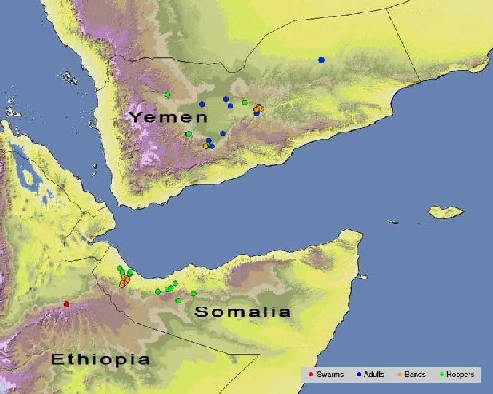
Hatching and band formation are in progress in Yemen and N. Somalia.
5 May. Desert Locust swarms breed in Yemen
The current Desert Locust situation remains a cause for concern in Yemen, northern Somalia and Ethiopia.
In Yemen, several small swarms and groups of adults that originated in southern coastal areas moved into the interior of Shabwah, Hadhramaut and Al Mahra last month. At least one swarm reached the central highlands near Dhamar where it is likely to remain or move towards the Red Sea coast or to the interior. Some of the adults have already laid eggs in Shabwah and more laying is expected between Marib and the Oman border where widespread rains fell a few weeks ago. Hatching will start in the coming days and the hoppers are likely to form small groups and bands throughout May.
In the Horn of Africa, several swarms that originated from the northwest coast of Somalia moved last month along the escarpment towards Burao as well as up the escarpment towards Hargeisa. A few swarms crossed into Ethiopia near Dire Dawa and the Harar Highlands. As widespread rains fell in early April, conditions are favourable for moderate scale breeding which is likely to produce hopper groups and bands during May in both countries.
All efforts are required by the affected countries to monitor the current infestations and undertake the necessary control operations in order to reduce the possibility of new swarms forming by mid June.
If swarms do form in Yemen, there is a moderate risk that they could move to the coast and then northeast across the Indian Ocean to the summer breeding areas along the Indo-Pakistan border in about late June. Any swarms that form in northern Somalia and northeast Ethiopia may remain there for the summer (if rains fall) or move towards the interior of central Sudan and the Indo-Pakistan border in July.
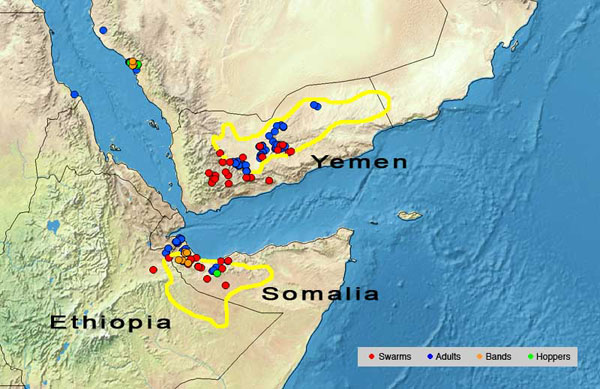
Swarms have moved to areas of recent rainfall (blue) in the interior of Yemen, N Somalia and Ethiopia where breeding will occur (in yellow), causing hopper bands to form.
20 April. Desert Locust swarms increase in Yemen and N Somalia
During the past week, more swarms have been reported in southern Yemen and, to a lesser extent, in northwest Somalia.
In southern Yemen, there were a dozen reports of small immature swarms that migrated into the interior of Shabwah (Ataq, Nisab, Bayhan) during the second week of April, reaching Marib and Al Abr. Thereafter, some immature and mature swarms were seen moving from west to east to villages in Wadi Hadhramaut (Shebam, Sayun). All of these swarms are thought to have originated from breeding that occurred on the southern coast in March. Unusually good and widespread rains fell in late March and early April throughout the interior desert of Shabwah, Hadhramaut and Mahra provinces from Marib to Shehan on the Oman border. These rains will allow ecological conditions to become favourable for breeding, and locusts will mature rapidly and lay eggs by the end of April. Hatching and band formation are expected to occur from early May onwards.
In northwest Somalia, ground control operations finished on 12 April against late instar hopper bands on the coast near Silil. The infestations that were not treated have now become adults. A few small swarms formed during the second week and moved from the coast up the escarpment to the east towards Burao and to the southwest towards Ethiopia. Scattered adults were reported in the railway area of Ethiopia while groups of gregarious mature were seen in adjacent areas of Djibouti near Holhol. As good rains fell in late March and early April on the coast, escarpment and plateau, the locusts are expected to mature and lay eggs within a large area between Dire Dawa and Jijiga (Ethiopia) and Silil and Burao (N Somalia).
All efforts are required by the affected countries to monitor the current infestations and undertake the necessary control operations in order to prevent locusts from increasing further and spreading to other countries in the Region.
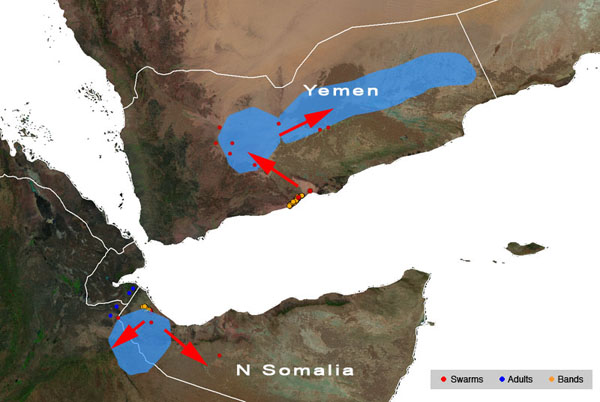
Swarms may move from the coast towards areas of recent rainfall (blue) in the interior of Yemen and N Somalia.
9 April. Desert Locust swarms form in Yemen and N Somalia
During the past week, a few small Desert Locust swarms have formed in southern Yemen and in northwest Somalia where control operations have ended.
In northwest Somalia, ground teams treated at least 100 ha of late instar hopper bands (wingless nymphs) in the past week on the northwest coast near Silil. Only a few hoppers remain but several swarms of immature adults have formed from infestations that were not fully controlled. On 6 April, an immature swarm moved from the coast up the escarpment to the plateau, reaching the Ethiopian border northwest of Boroma and southeast of Aysha (Ethiopia). On the same day, another swarm was seen flying from the coast up the escarpment towards Hargeisa. Some of the adults are remaining on the coast, for example east of Lughaye where groups of adults were seen copulating on the 9th. Good rains fell recently on the coast, escarpment and plateau from Lughaye and Bulhar to Dire Dawa in Ethiopia. Consequently, adult groups and swarms are likely to disperse in these areas and eventually lay eggs if conditions are favourable. Therefore, intense monitoring is required in both countries during April.
In southern Yemen, local police reported swarms in Abyan and Shabwa provinces on 5 April that may threaten crops. Locusts had also reached Ataq and nearby areas. The swarms formed from residual populations that national teams treated during the last half of March along a 90 km stretch of the southern Yemeni coast southwest of Mukalla. As conditions have dried out on the coast, it was expected that small groups and swarms would form and move towards the interior of Shabwa and Hadhramaut and perhaps Mahra. Good rains fell in these provinces at the end of March and in early April that may allow adults to mature and lay eggs in May.
National survey and control teams finished ground operations along the coast on 1 April. Teams are due to be redeployed shortly to the interior to follow up the recent swarm sightings.
All efforts are required by the affected countries to monitor the current infestations and undertake the necessary control operations in order to prevent locusts from increasing further and spreading to other countries in the Region.
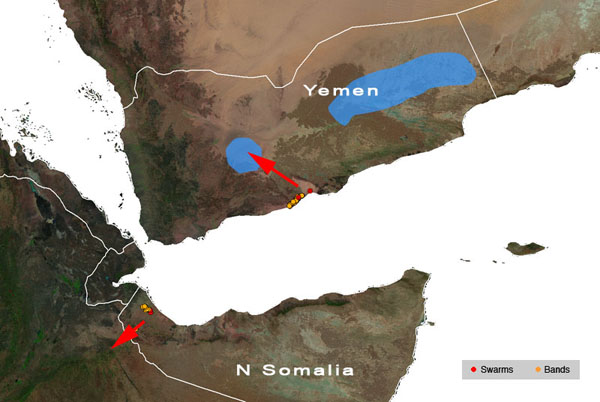
Swarms may move from the coast towards areas of recent rainfall (blue) in the interior of Yemen and N Somalia.
2 April. Desert Locust outbreaks in Yemen and N Somalia
During the past few weeks, two Desert Locust outbreaks developed - one in Yemen and another in northern Somalia.
In Yemen, heavy rains and floods in October 2008 created favourable ecological conditions for breeding during the winter along the central part of the southern coast. Small groups of adults laid eggs in early February and more than 200 small hopper bands formed during March along a 90 km stretch of coast southwest of Mukalla. Currently, most of the hopper bands are in their final stage before they fledge, obtain wings and become adults. Fledging is already underway and so far two small swarms of 2 sq. km each have been reported. Although ground control teams have treated nearly 5,000 ha since 18 March, any remaining locusts that are not controlled will fledge and the new adults will form small groups and swarms. As conditions have dried out on the coast, the adult groups and swarms are expected to move to the summer breeding areas in the Shabwa interior near Bayhan where good rains have fallen in the past few days.
In northern Somalia, a small outbreak developed in late February and early March within an area of unusually green vegetation on the northwest coast near Silil, about 65 km by 20 km in size. During the first week of March, small groups of mature gregarious adults, a small copulating swarm, and a few hopper bands were present. Intensive surveys subsequently found nearly two dozen very small to medium sized hopper bands and two small mature swarms, each about 2.5 sq km in size. Ground control operations are being organized and should start shortly. Although the locust infestations are expected to remain on the coast because vegetation is still green, there is a risk that adult groups and a few small swarms could move up the escarpment towards Ethiopia or east along the escarpment towards Erigavo once the vegetation dries out.
All efforts are required by the affected countries to monitor the current infestations and undertake the necessary control operations in order to prevent locusts from increasing further and spreading to other countries in the Region.

Swarms may move from the coast towards areas of recent rainfall (blue) in the interior of Yemen and N Somalia.
19 March. Desert Locust populations gregarizing on NW Somalia coast
Ground surveys in the past week have confirmed that local Desert Locust populations are concentrating and gregarizing in a few places on the coast in northwest Somalia near Silel and the Djibouti border. Important infestations were seen at three places during ground surveys along the coastal plains. The infestations consist of two medium-sized dense hopper bands and a 2.5 square km medium-density mature swarm. Low numbers of gregarious hoppers and adults were also seen.
The mature adults and swarm will probably remain on the northwest coast because vegetation is still green and soil is moist. Egg-laying is likely to take place by the end of the month, followed by hatching about two weeks later.
The two hopper bands will fledge and new immature adults will start to appear at the end of March and continue until about mid-April. These immature adults are likely to stay on the northwest coast as long as vegetation remains green. Once conditions start to dry out, there is an increasing risk that the immature adults will leave the coast. At present, the most likely direction is towards the southwest up the escarpment to the railway area in Ethiopia between Dire Dawa and the Djibouti border. However, this could change and there is a slight risk that adults might move east along the coast and escarpment towards Berbera and Burao, or move northwards across the Gulf of Aden to southern Yemen.
Therefore, intensive surveys should be carried out during the next month in northern Somalia, eastern Djibouti and in eastern Ethiopia (railway and Jijiga areas) to monitor the situation carefully for any signs of additional infestations. Surveys are also suggested along the southern coast in Yemen as a preemptive measure in case adults move across the Gulf of Aden during periods of favourable winds.
FAO will continue to keep countries informed of any significant developments.
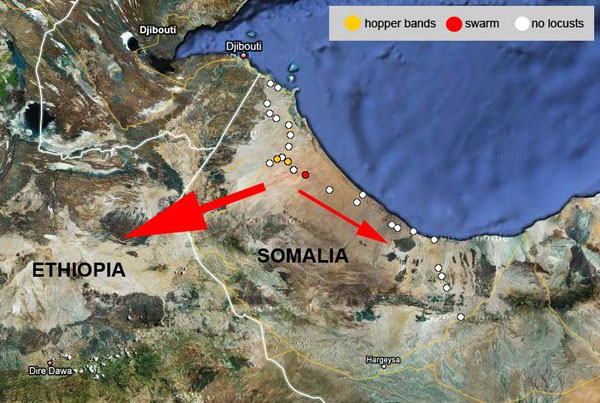
Once vegetation dries out, adults are likely to move inland to the plateau in E. Ethiopia or perhaps east along the northern Somali coast.
2 March. Limited Desert Locust activity continues in NW Mauritania and along the Red Sea
The Desert Locust situation continues to remain calm because of very little rainfall in the recession area during the past few months. Consequently, ecological conditions are not favourable for breeding except for a few places in northwest and northern Mauritania, Western Sahara and along parts of the Red Sea coastal plains in Sudan, Eritrea, Saudi Arabia and Yemen. Unless further rains fall, winter breeding will end and locust numbers will decline in these countries.
Small-scale hatching in mid-March will cause locust numbers to increase slightly on the southern coast of Yemen where heavy rains fell four months ago.
Spring breeding is expected to commence on the southeast coast of Iran during March and may extend to coastal areas of western Pakistan if rains fall.
The situation is likely to remain calm in all countries and no significant developments are expected during March and April.
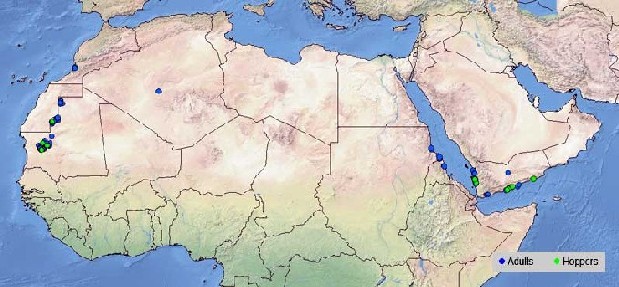
Only low numbers of Desert Locust hoppers and adults are present in parts of the recession area.
2 February. Limited Desert Locust activity in NW Mauritania and along the Red Sea
The Desert Locust situation remains calm in all regions. Limited ground control operations continue against small residual populations of solitarious hoppers and adults in northwest Mauritania. Low numbers of hoppers are present in adjacent areas but, so far, only isolated adults have been seen in the north of the country.
Small-scale breeding is in progress in the winter breeding areas along both sides of the Red Sea, mainly on the northern coastal plains in Eritrea and, to a lesser extent, on the coast in Sudan, Saudi Arabia and Yemen.
During the remainder of this month, local breeding is expected to continue along the Red Sea. Small-scale breeding is likely to commence in parts of northern Mauritania and Western Sahara as well as on the coast in northwest Somalia, northern Oman, southeast Iran and western Pakistan. Breeding will be limited and locust numbers are expected to remain low and non-threatening.
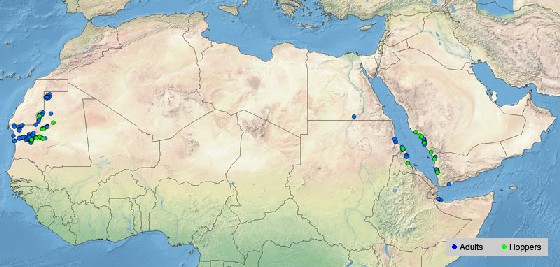
Only low numbers of Desert Locust hoppers and adults are present in parts of the recession area.




